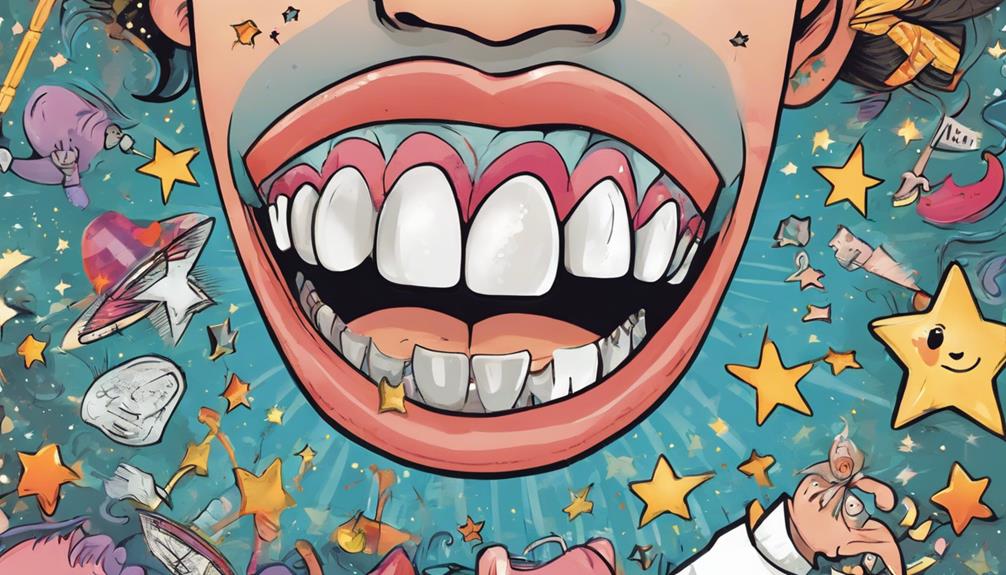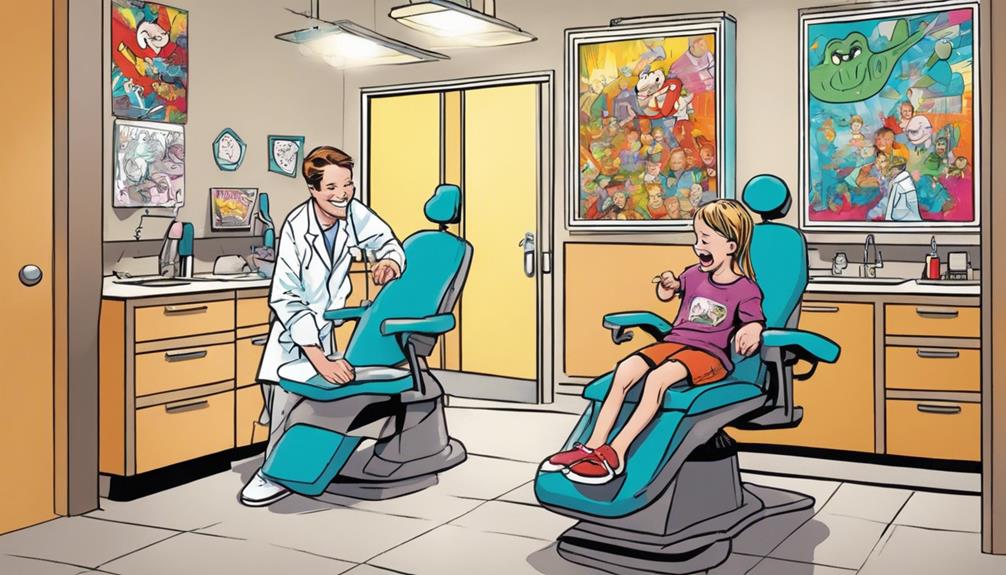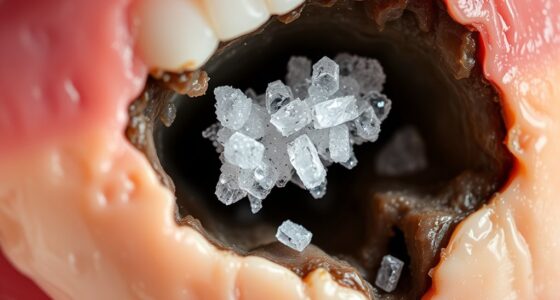You typically lose all 20 baby teeth between ages 5 and 12, starting with the lower central incisors around ages 5 to 6. Next, you'll shed the upper central incisors between 6 and 7. The lateral incisors follow, usually lost from ages 7 to 8. From ages 9 to 11, you'll lose the first molars, and then the canines and second molars typically come out between 9 and 12. Each tooth loss makes way for your permanent teeth. If you want to explore more about the factors influencing tooth loss, stick around for the details!
Key Takeaways
- Baby teeth typically start to fall out between ages 5 and 6, beginning with the lower central incisors.
- Upper central incisors are lost between ages 6 and 7, followed by lateral incisors from ages 7 to 8.
- First molars usually shed between ages 9 and 11, while canines are lost between ages 9 and 12.
- Second molars are typically the last to be lost, with most children losing all baby teeth by age 12 or 13.
Timeline for Losing Baby Teeth

You're likely to notice your child starting to lose their baby teeth around ages 5 to 6, with the lower central incisors usually being the first to go. This is an exciting milestone as your child begins to lose their first tooth, marking the change from baby teeth to permanent teeth.
Typically, the lower central incisors fall out first, followed by the upper central incisors, usually between ages 7 and 8. After that, the lateral incisors join the mix, also lost during the ages of 7 to 8.
As your child approaches ages 9 to 12, they'll likely shed their canines and first molars. The entire process continues until they're about 12 years old, at which point most kids have lost all 20 baby teeth. However, some may still lose a few teeth until around age 13.
It's important to understand that this timeline can vary from child to child, influenced by factors like genetics and overall health. Regardless of the exact timing, this natural process is essential for proper jaw development and the alignment of adult teeth.
Order of Tooth Loss

The order in which children lose their baby teeth follows a predictable pattern, starting with the lower central incisors and progressing through various types of teeth until all 20 have been shed. You'll notice that this process usually begins around ages 5 to 6, with specific teeth falling out in a defined sequence.
Here's the typical order of tooth loss:
- Lower central incisors: First to go, usually around ages 5 to 6.
- Upper central incisors: Next, commonly lost between ages 6 and 7.
- Lateral incisors: Both upper and lower incisors are shed between ages 7 and 8.
- First molars: Typically lost between ages 9 and 11.
Understanding this order helps you anticipate when your child will lose their baby teeth, paving the way for those permanent ones to come in!
Reasons for Losing Baby Teeth

Baby teeth fall out primarily to make room for the permanent teeth that are growing beneath them. This natural process typically begins around age 6, with the lower central incisors being the first to go. As your child's dental development progresses, the roots of baby teeth dissolve, allowing the new teeth to emerge without obstruction.
However, not all reasons for losing baby teeth are linked to this normal development. Tooth decay can cause premature loss, which might disrupt the alignment of the permanent teeth. If your child experiences early tooth loss due to decay or trauma, it can lead to a misalignment that may require orthodontic intervention later on.
Maintaining good dental hygiene is vital during this time to prevent decay and guarantee healthy development of the teeth. Regular dental check-ups can help you monitor the condition of your child's baby teeth and catch any problems early.
Ultimately, while losing baby teeth is an important part of growing up, it's important to keep an eye on your child's dental health to guarantee a smooth shift to their adult teeth.
Factors Influencing Tooth Loss

Understanding the various factors that influence tooth loss can help you better support your child's dental health during this essential shift. Several key elements come into play when it comes to losing baby teeth and evolving to permanent teeth.
- Genetics: Family history can determine when and how your child loses their baby teeth.
- Dental health: Good oral hygiene practices, like regular brushing and flossing, keep baby teeth in better condition.
- Nutrition: A balanced diet is vital; high sugar intake can lead to decay, increasing the risk of early tooth loss.
- Environmental factors: Accidents or injuries can cause premature loss of baby teeth, disrupting their natural shedding.
Care During Tooth Loss

As your child starts to lose their baby teeth, taking care of their dental health becomes even more important to guarantee a smooth process. Regular dental check-ups are essential during this change. Encourage good oral hygiene practices, like brushing and flossing, to maintain their dental health.
Be on the lookout for signs of discomfort, such as swelling or persistent pain, and consult a dentist if you notice these symptoms. Providing soft foods can help ease any discomfort while eating, making the experience more manageable for your child.
Celebrating milestones, like losing a tooth, can make the process more positive and reduce any anxiety your child may feel. Here's a helpful table to keep track of tips during this stage:
| Care Tips | Description | Benefits |
|---|---|---|
| Regular Dental Check-ups | Schedule visits starting at age 1 | Monitor tooth development |
| Good Oral Hygiene | Encourage brushing and flossing | Prevent cavities |
| Watch for Discomfort | Look for signs of pain or swelling | Early intervention |
| Soft Foods | Offer easy-to-chew options | Comfort during eating |
| Celebrate Milestones | Make losing a tooth a fun event | Positive reinforcement |
Importance of Baby Teeth

Baby teeth are more important than you might think.
They not only help your child speak clearly but also guide the proper alignment of adult teeth.
Role in Speech Development
The presence of primary teeth is fundamental for children's speech development, enabling them to articulate sounds and words accurately. As a parent, you should understand how important baby teeth are in shaping your child's ability to communicate effectively. Here are some key roles they play:
- Jaw Alignment: Baby teeth help maintain proper jaw alignment, facilitating sound formation.
- Sound Production: Certain sounds like 's,' 't,' and 'd' depend on the positioning of teeth, making their presence critical.
- Oral Motor Skills: Healthy baby teeth support the development of oral motor skills, pivotal for clear speech.
- Language Acquisition: The presence of baby teeth is linked to smoother language acquisition during early childhood.
Maintaining your child's baby teeth is fundamental not just for their dental health but also for their overall speech development. By ensuring they've healthy baby teeth, you're giving them the best chance to articulate their thoughts and feelings as they grow.
Guide for Permanent Teeth
Healthy primary teeth are essential for guiding the proper alignment and eruption of your child's permanent teeth, helping to prevent future dental issues. When your child begins losing their baby teeth, usually starting around age 6, it's critical to guarantee their dental hygiene is excellent. These 20 baby teeth, which emerge between 4 to 12 months, pave the way for 32 permanent teeth, making their health fundamental for a smooth shift.
Maintaining good dental hygiene during this stage not only protects your child's first set of teeth but also supports their overall oral health. Healthy primary teeth contribute to proper speech development, allowing your child to communicate effectively. If baby teeth are lost too early or are unhealthy, it can lead to misalignment of permanent teeth, causing crowding or other dental issues down the line.
As your child navigates losing their baby teeth, keep an eye on the sequence of loss, starting with the lower central incisors. This order guarantees that the adult dentition develops correctly. By prioritizing your child's dental care now, you're setting them up for a lifetime of healthy smiles.
Signs of Tooth Eruption

Around 6 months of age, you'll likely notice the first signs of tooth eruption, starting with the lower central incisors breaking through the gums. This teething phase can be tough for both you and your child, as they may experience various symptoms while their baby teeth come in.
Look out for these signs of teething:
- Increased drooling
- Irritability or fussiness
- Chewing on objects to relieve discomfort
- Swelling and tenderness in the gums
As each child's experience is unique, some may show more pronounced signs than others. The eruption process can lead to localized swelling where the tooth is emerging, causing discomfort. It's common for your child to be a bit cranky during this time.
Oral Care Tips

To keep your child's smile bright, establish a daily brushing routine with fluoride toothpaste and a soft toothbrush.
Don't forget to introduce flossing as soon as their teeth touch, ensuring you tackle those hard-to-reach areas.
Regular dental check-ups every six months will help catch any issues early and support their overall oral health.
Daily Brushing Routine
How can you guarantee your child develops a strong daily brushing routine for better oral health?
Start by establishing a consistent schedule. Encourage your little one to brush their teeth at least twice a day—once in the morning and once before bedtime. This habit helps protect those precious baby teeth until they naturally fall out, making way for permanent adult teeth.
Here are some tips to make brushing enjoyable and effective:
- Use a soft-bristled toothbrush and a pea-sized amount of fluoride toothpaste for kids under six.
- Set a timer or play a fun song to ascertain they brush for at least two minutes.
- Supervise your child while they brush, helping them focus on all surfaces of their teeth and gums.
- Incorporate daily flossing into their routine to remove food particles and plaque from between teeth.
Importance of Flossing
While brushing is important for your child's oral health, flossing plays a key role in cleaning those hard-to-reach areas between teeth. Establishing a flossing routine early, ideally when baby teeth touch, helps prevent cavities and gum disease. Introduce flossing around age 2 or 3 to promote good oral hygiene habits from the start.
Here's a quick guide to help you incorporate flossing into your child's daily routine:
| Step | Tip |
|---|---|
| 1. Timing | Floss once a day, preferably at night. |
| 2. Technique | Use a gentle sawing motion to avoid gum damage. |
| 3. Supervision | Help younger children until they can do it alone. |
| 4. Encouragement | Praise their effort to build healthy habits. |
Regular Dental Check-Ups
Regular dental check-ups are essential for monitoring your child's oral health and ensuring their teeth develop properly. It's important to start these visits by age 1 and continue every six months. This proactive approach allows you to catch potential issues early and provides a solid foundation for good oral hygiene practices.
Here are some key benefits of regular dental visits:
- Track tooth development: Dentists assess the timing of baby tooth loss and the emergence of permanent teeth.
- Prevent problems: Early dental visits help identify any issues before they become serious.
- Build comfort: Creating a positive relationship with the dentist reduces anxiety for your child as they grow.
- Receive guidance: Dental professionals provide tailored advice on oral hygiene practices suitable for your child's age.
Common Concerns

Losing baby teeth can raise several common concerns for parents, especially when it happens earlier than expected. If your child starts to lose their teeth before age 4, it's understandable to be worried. Early loss can lead to misalignment of the permanent teeth, which might require a visit to the dentist for further evaluation.
Typically, children lose their baby teeth around ages 6 to 7, beginning with the lower central incisors. If you notice that your child is losing their teeth considerably out of order or retaining baby teeth longer than expected, these can also be areas of concern. Retained baby teeth may disrupt the normal eruption of permanent teeth, making it essential to keep an eye on their dental development. Understanding baby tooth loss is important for parents to ensure that their child’s oral health is on track. If you have any concerns about the timing or order of your child’s baby tooth loss, it’s best to schedule a dental check-up for further evaluation. A dentist can provide guidance on the best course of action to support your child’s dental development and address any potential issues.
Most children will lose all 20 primary teeth by around age 12, but this timeline can vary. Staying informed about the process helps you address any issues promptly. If you have ongoing concerns about your child's teeth, don't hesitate to consult your dentist. It's better to be proactive when it comes to dental health.
When to Consult a Dentist

Knowing when to consult a dentist is essential for your child's dental health.
If your child loses a baby tooth too early or hasn't lost any by age 7, it's time to get them checked out.
Regular visits can help catch potential issues before they become bigger problems.
Signs of Dental Issues
If your child experiences persistent pain, swelling, or bleeding in the gums, it's vital to consult a dentist without delay. These symptoms can signal dental issues that need immediate attention.
You should also keep an eye on other signs that may indicate a problem:
- Losing a tooth before age 4 could suggest potential misalignment of adult teeth.
- If your child hasn't lost their first tooth by age 7, it's wise to consult a dentist to assess permanent teeth development.
- Early loss of baby teeth can cause neighboring teeth to drift into empty spaces, leading to alignment issues.
- Retained baby teeth beyond age 12 may require evaluation for proper dental alignment.
Age for Dental Visits
Regular dental visits are key to monitoring your child's oral health and catching any potential issues early on. It's recommended that you schedule the first dental appointment by the age of 1. This early visit sets the stage for good dental hygiene practices and allows the dentist to track your child's dental health and development.
From that point forward, regular dental visits every six months are essential. During these check-ups, the dentist can monitor the progression of tooth eruption and overall oral health. If you notice any delays in tooth eruption or shedding—especially if your child is about a year behind the typical age—it's important to consult a dentist.
As your child approaches age 6, monitoring the timeline of baby teeth loss becomes increasingly important. This helps guarantee proper alignment and health of permanent teeth as they start to come in.
Frequently Asked Questions
Do You Lose All 32 Baby Teeth?
You don't lose all 32 baby teeth because you only have 20 baby teeth in total. As you grow, those 20 are replaced by 32 permanent teeth, shaping your smile for adulthood.
Which Baby Teeth Fall Out Chart?
You can find charts detailing the order in which baby teeth fall out online or in dental offices. They typically show the sequence, starting with lower central incisors around age 6, making it easy to track.
Which Baby Teeth Should Fall Out?
You're in for a wild ride as your child's teeth begin their grand exit! The first to go are usually the lower central incisors, followed by the upper ones, then the rest in succession.
Do You Lose Your Molars?
Yes, you do lose your molars. Typically, your first molars come out between ages 9 and 11, while the second molars are usually lost between ages 10 and 12, making way for permanent teeth.
Can Grinding Baby Teeth Cause them to Fall Out Sooner?
There are several baby teeth grinding reasons, but it’s a common concern whether it can cause them to fall out sooner. In most cases, occasional grinding won’t affect the timing of tooth loss. However, excessive grinding due to stress or misaligned teeth can potentially lead to premature loss.
Conclusion
In the journey of growing up, losing baby teeth is a rite of passage that marks your child's shift into adulthood.
As their smiles change, it's important to embrace this natural process with care and guidance.
Remember, each lost tooth makes room for a stronger, more confident smile.
By staying informed and supportive, you're not just managing tooth loss; you're nurturing your child's growth, helping them shine brighter as they step into the world ahead.









